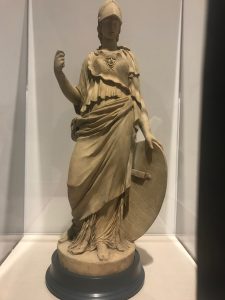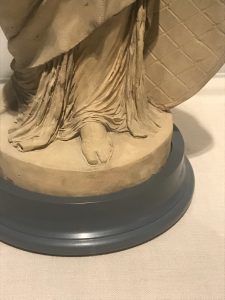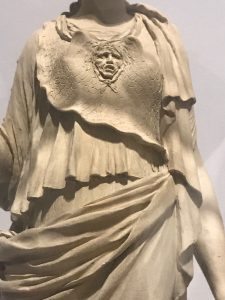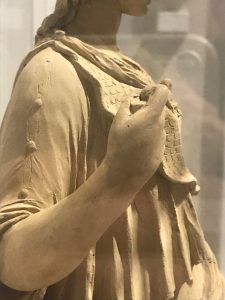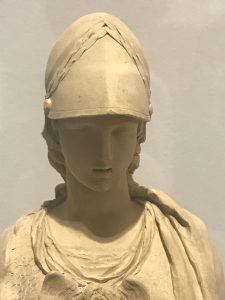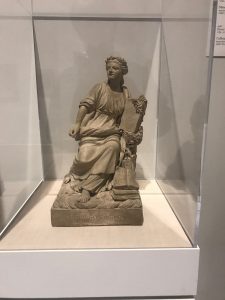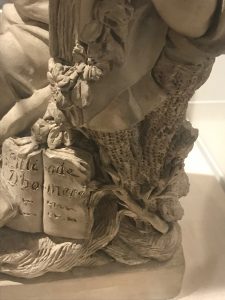In the Ackland’s newest exhibit, Becoming A Woman In The Age of Enlightenment: French Art, all pieces of artwork focuse on the depictions of women. Claude-Michael’s, known as Clodion, terracotta statue Minerva opened the exhibit. Minerva depicts the ancient Etruscan goddess of wisdom, art, war, schools and commerce. Her Greek counterpart is the goddess Athena. Without any foreknowledge of the name, viewers could assume the statue depicted a Greek or Roman Goddess or Princess. The telltale greek sandals (Figure 2), helm (Figure 5), incrusted breast plate (Figure 3), and the flowing robes illustrate her high rank in society.
I believe the statue was either formed via coiling, or it was carved more similarly to a wood statue from a large block of clay. This assumption comes from the distincition that Minerva is not a perfectly symmetrical piece of art, and therefore could not have been thrown on a wheel. One of the keys when creating a work of clay, whether you are coiling or throwing on a wheel, is the base. Upon glancing at the base of the statue, near Minerva‘s feet, you will notice a distinct line around it. Based upon a lesson in basic ceramic practices, I noticed this mark looks similar to that of a structure removed from its original area of creation. This means that the statue was sculpted then cut from its origin, fired, and placed with some form of adhesive to the base of this figure.
The fine detail and precision worked into Minerva‘s breastplate catches viewers eyes easily. This pattern is so uniform many may believe it was imprinted or pressed into the figure. But, when observed closely, you can see small amounts of excess class formed around the edges of each line. I hypothesis this shows a technique based upon a small sharp pointed tool, that could produce even clear lines, even on a raised and curved surface of the breastplate. As well, on the centerfold of the plate is a highly detailed, delicately placed sculpture of Medusas head, featuring her signature snake hair. Based upon the amount of detail, I imagine Clodion formed this separately and attached it to the figurine before the firing process.
It appears as though the statue once held an object. Based upon the clean break I imagine Minerva was at one point holding some spherical object that has since been separated from the original work of art. At first glance, I was reminded of Lady Liberty’s torch, or Perseus with the Head of Medusa. However, when thinking about the firing process of the clay, I imagined that the object she was holding may have been fired in a separate process, and reattached afterwards. The break that we see in the picture above may have been achieved decades later after the object broke, and the only remnants are within her grasp.
Minerva‘s helm has an intricate wreath laid upon it. Upon further glance the wreath is constructed of individual leaves of clay, most of which have small finger prints, which were then carefully laid upon the top of the helm. These leaves must have been sculpted separately and then positioned. The attention to detail, and painstaking patience this must of taken is shown throughout the piece. However, Clodion made a calculated decision to leave his finger prints on the piece. While small amounts of water could smooth these imperfections out of the piece, Clodion deliberately chose not to. It may be speculated that he did not have the tools to remove the prints on the small pieces of added clay, but his marks are also situated on other spots of the piece.
Directly next to Clodion’s Minerva, was a similar work called Calliope, by Pierre Surugue. Featuring similar themes and motifs, Calliope features Calliope, who is the muse who presides over eloquence and epic poetry in Greek Mythology. The flowing gowns were common place in Ancient Greece, and were then perfected via clay. Both artists Surugue and Clodion mastered the perfect texture to each fold within the medium of average clay. I believe part of this mastery came with certain apparatuses, such as the loop and wire tools. These tools have small pieces of metal looped into a certain shape that enables the artist to carve away pieces, and form specific shapes. This would explain the considerable overlap in shapes and patterns between the two pieces. A texture unseen in Minerva, but very prevalent in Calliope is the extensive small hole. After some research, this type of hole was formed by a Potter’s needle, which in this case adds a texture looking like that of corn. As well, Potter’s Needles can be used to write script or add clear and exact detail. I hypothesis that Potter’s Needles were used to create the flowers seen in Figure 7, and the details on Minerva’s dress sleeve in Figure 4.
It is clear during the time when both Clodion and Surugue were active, and clay was being used, glazes were not commonplace. Most glazes were used on either bowls or jugs in an attempt to make them impermeable to water; however, these statues had no such need, and therefore were not glazed. The terracotta style was widely appreciated and approved of because of the immense quantity and quality of detail that could be developed therein.
